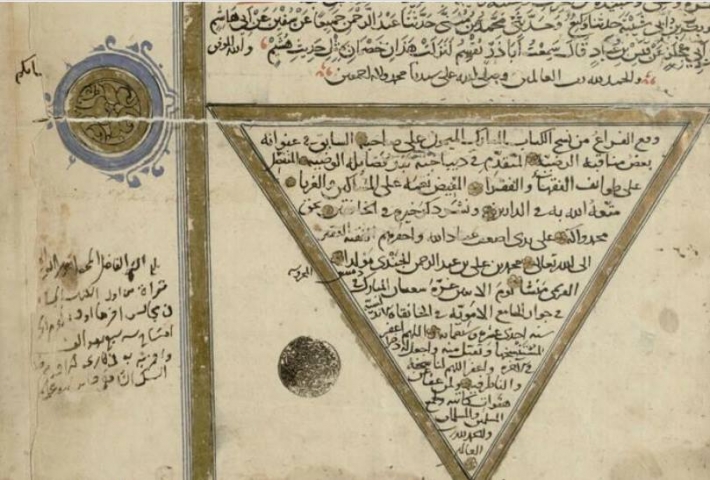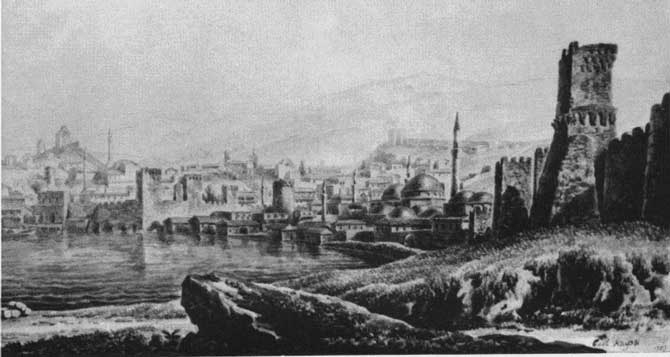Many scientists have tried to answer the question: when the first Muslims appeared on the territory of the Crimean Island. This question is not about individual faithful, who certainly could live in the Crimea already in the early Middle Ages, but it is about the larger Muslim communities that disposed of Islamic justice, mosques, cultural traditions. The famous legend says that it happened in the time of the companions of Prophet Muhammad (peace be upon him). And the documentary evidences indicated the first half of the XIII century, when the first mosque considered to be built in Kaffa (now Feodosia) that was captured by the Seljuks in 1221. Already in the second half of the same century, in 1288, a mosque was built in Solhat (now Staryi Krym), according to the order of Mamluk Sultan of Egypt, Zahir ad-Din Baibars, who supposedly was the Crimean by descent. But the "mass" Islamization, it means when Islam became the official religion, began only after enthronement of Golden Horde Khan, Muhammad Uzbek (1313/1314 years). As we know from the story of Arab traveler Ibn Battuta, who visited the Crimea in May 1334, there already were sharia judge (according to madhhabs of Abu Hanifa and al-Shāfiʿī), mosques, a lot of Sufi sheikhs’ "monasteries", and madrassas. It means that there was the extensive religious infrastructure in the Crimea.
However, we know not so much about the previous XIII century. According to the number of Crimean Tatar researchers, a Turkic poem "Kyssa i-Yusuf," was written by local author, Mahmoud Kırımlı, in 1220's. The first religious work (which described the Islamic doctrine) is the well-known "Kalandar-name"by Abu Bakr Kalandar written in Persian in 1320's. However, Abu Bakr Kalandar wasn’t from the Crimea, but from Anatolia; the only copy of work was found in 1966 in Namangan (Uzbekistan), but its thorough research has been started just recently, due to the facsimile edition (Kazan, 2015). Available and partial translations have been published in “Golden Horde Rewiev”.
In the same XIV century also lived two authors: Diya ad-Din al-Qirimi (d. 1379) and Rukn ad-Din al-Qirimi (d. 1382). The first came from Qazvin (now Iran), lived in the Crimea, and later moved to Egypt. At least one of his works has remained. It is his compendium of work by theologian and lawyer Al Baydavi "Method of understanding the fundamentals of law" that is available for study in the library of Al Halidiya in the Israeli part of Jerusalem. The second author, Rukn ad-Din al-Qirimi, is a Crimean by descent and supposedly was working there as a judge; later he moved to Egypt, and left behind several works, among those is the extant interpretation of verse "Yusuf" (the only known copy is kept in the library of King Abd al-Aziz in Medina, Saudi Arabia).
There is also one more very interesting manuscript that has remained to nowadays. According to precise date and documented author’s relation to the Crimea, this document is considered to be the first Arabic religious text, rewritten by inhabitant of the Crimea. It is a manuscript, which is a copy of a famous hadith collection “Dzamiy as-Sahih” by Muslim al-Qushayrī. It is kept in the National Library of Israel (Jerusalem) under the designation Ms. Yah. Ar. 103. This work along with a collection of al-Bukhari is the most significant text of Sunnah. There are thousands of manuscripts of this work. It was printed and translated for 10 times, but this copy is interesting because it was rewritten by the Crimean author. The last page of the manuscript has the inscription: "The book has been completed... by the hand of the weakest and the neediest servant of Almighty Allah, Muhammad bin Ali bin Abd ar-Rahman al-Jandi by birth, Al Qirimi by origin, on the fourth day ...of the blessed month Shaaban of 711 A.H., near the Umayyad Mosque in Damascus in the Andalusian monastery ". So we have the clearly stated date that is 4 Shaaban 711 year, ie December 15, 1311 according to the Gregorian calendar. Even these few lines let us track author’s way of life.
So, this Ali bin Muhammad bin Abd ar-Rahman came from the city of Jand (Jend). This city is mentioned by many Arab geographers (eg “mu'jam al-buldān” written by Yaqut al-Hamawi in 1220's, contains the article about it) and it was located in the southern part of modern Kazakhstan. Formerly, it was the center of Kipchak association; even the Aral Sea was called "Sea of Jend". According to the historian Rashid ad-Din, Mongols captured, looted and devastated Jend in April 1220. However, the city was easily reborn as not political but commercial centre. The city had long-standing scientific and religious traditions: For example, a scholar and a poet Yakub bin Shirin Al Jandi (XII century) and Sufi Muyid al-Din al-Jandi (d. 1292), a student and commentator of Ibn Arabi’s works, were born there.
Probably, the invasion of Genghis Khan forced many scientists to leave Jend and somehow Muhammad bin Ali bin Abd ar-Rahman came to the Crimea. A clear indication of “Al Qirimi al-Mansha-an” ("Al Qirim by origin") proves that the author grew and developed as a scientist in the Crimea. It is significant that, despite living in Damascus, Muhammad bin Ali bin Abd ar-Rahman didn’t add toponomic surname Al-Dimashki ("from Damascus") to his name, so he considered the Crimea to be his native country, by which other scientists could recognize him. At the turn of XIII-XIV centuries, Crimea became a refuge for scientists from Central Asia, Persia and other regions. They fled from military actions, epidemics of plague and due to other reasons. Such situation favoured the emerging of scientific links. In the second half of the XIII century, an Islamic education already existed in the Crimea that was long before well-known madrassas. Unfortunately, we do not expose any information about teachers or other details of life of Ali bin Muhammad bin Abd ar-Rahman in the Crimea but there is no doubt that he had been living there for a very long time before he moved to Damascus.
For some reasons, Muhammad bin Ali bin Abd al-Rahman moved to Damascus, perhaps in order to continue his education. The "Andalusian monastery", mentioned by him, was not far from the famous Damascus Umayyad mosque. It was built about 1242 by order of Abu Abdullah Muhammad Al-Andalus, but unfortunately, it has not survived. This Sufi institution served as madrasa, place for public prayers and residence for scholars. It was famous for its sheikhs. According to the historian Ibn Kasira, Shafi'i hadith expert Amin ad-Din al-Ashtar al-Halabbi (d. 1282) taught there and he was highly appreciated by Muhi ad-Din al-Navavi, the author of "The Gardens of the Righteous ". Iraqi Sufi Muammar ibn al Fahir Al Wasiti (d. 1299) also lived there. In the following XIV century, according to Ibn Qadi Shuhba, "Sheikh of Damascus grammarians" Shihab ad- Din al-Utabi (d. 1375) spent the last years of his life at the "Andalusian monastery". He was a pupil of the famous interpreter of the Koran, Hayan Abu al-Andalus. We can suppose that Muhammad bin Ali bin Abd ar-Rahman al-Qirimi, like his contemporaries, also was not just a copyist. Most likely, some sheikh of the monastery was his teacher, perhaps, the same Amin ad-Din al-Halabbi.
The copying of the whole Sunnah was a very responsible work, obviously, only a person, who had special background of hadith studies, was able to do that. Unfortunately, Muhammad bin Ali bin Abd al-Rahman al-Qirimi was not mentioned in the known biographical sources. Although there were scientists, who had the toponymic name Al Qirimi, in Damascus in the next IX century AH (XV AD), according to known historian Shams ad-Din as-Sahawi, who lived at those times. Some of them could be descendants of Muhammad bin Ali bin Abd al-Rahman.
It is hardly to track where the manuscript were during these centuries, but the inscription on the margins shows that a certain Nur ad-Din was reading this book during some meeting (Majlis) in 1007 AH (1599 AD). Also there is an Ottoman illegible stamp on the page, which only indicates a year — 111(?), it means the time between 1698 and 1708 years. Probably, it had been keeping in Damascus before the famous linguist and collector Abraham Yehuda (1877-1951) found it. He left behind a huge collection of Arabic manuscripts. Part of this collection is kept in the National Library of Israel now, another part is in the library at Princeton University (USA).
The value of the manuscript, written by Ali bin Muhammad bin Abd ar-Rahman al-Qirimi, is hard to overstate. This is the first known Arabic text, rewritten by the author, who related directly to the Crimea. Although this is just a copy of another work, the age of the document allows us to revise established views on Islam in Crimea, confirming the significant level of science before the Golden Horde Islamization, namely in the second half of XIIII century. We hope the new findings will give us a deeper insight into this exciting time.



